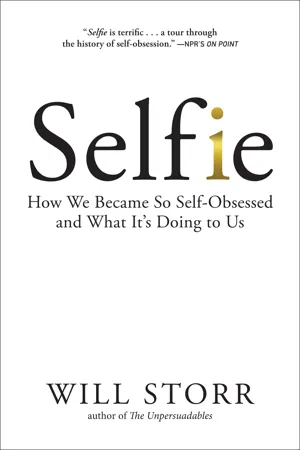
- 416 pages
- English
- ePUB (mobile friendly)
- Available on iOS & Android
About this book
"An intriguing odyssey" though the history of the self and the rise of narcissism ( The New York Times ). Self-absorption, perfectionism, personal branding—it wasn't always like this, but it's always been a part of us. Why is the urge to look at ourselves so powerful? Is there any way to break its spell—especially since it doesn't necessarily make us better or happier people? Full of unexpected connections among history, psychology, economics, neuroscience, and more, Selfie is a "terrific" book that makes sense of who we have become (NPR's On Point ). Award-winning journalist Will Storr takes us from ancient Greece, through the Christian Middle Ages, to the self-esteem evangelists of 1980s California, the rise of the "selfie generation, " and the era of hyper-individualism in which we live now, telling the epic tale of the person we all know so intimately—because it's us. "It's easy to look at Instagram and selfie-sticks and shake our heads at millennial narcissism. But Will Storr takes a longer view. He ignores the easy targets and instead tells the amazing 2, 500-year story of how we've come to think about our selves. A top-notch journalist, historian, essayist, and sleuth, Storr has written an essential book for understanding, and coping with, the 21st century." —Nathan Hill, New York Times -bestselling author of The Nix "This fascinating psychological and social history... reveals how biology and culture conspire to keep us striving for perfection, and the devastating toll that can take."— The Washington Post "Ably synthesizes centuries of attitudes and beliefs about selfhood, from Aristotle, John Calvin, and Freud to Sartre, Ayn Rand, and Steve Jobs." — USA Today "Eminently suitable for readers of both Yuval Noah Harari and Daniel Kahneman, Selfie also has shades of Jon Ronson in its subversive humor and investigative spirit." — Bookseller "Storr is an electrifying analyst of Internet culture." — Financial Times "Continually delivers rich insights... captivating." — Kirkus Reviews
Frequently asked questions
- Essential is ideal for learners and professionals who enjoy exploring a wide range of subjects. Access the Essential Library with 800,000+ trusted titles and best-sellers across business, personal growth, and the humanities. Includes unlimited reading time and Standard Read Aloud voice.
- Complete: Perfect for advanced learners and researchers needing full, unrestricted access. Unlock 1.4M+ books across hundreds of subjects, including academic and specialized titles. The Complete Plan also includes advanced features like Premium Read Aloud and Research Assistant.
Please note we cannot support devices running on iOS 13 and Android 7 or earlier. Learn more about using the app.
Information
Notes and references
Table of contents
- Cover
- Title Page
- Copyright
- Contents
- Dedication
- A note on the text
- Book Zero: The Dying Self
- Book One: The Tribal Self
- Book Two: The Perfectible Self
- Book Three: The Bad Self
- Book Four: The Good Self
- Book Five: The Special Self
- Book Six: The Digital Self
- Book Seven: How to Stay Alive in the Age of Perfectionism
- Acknowledgements
- A note on my method
- Notes and references
- Index